The NVIDIA GeForce RTX 2080 Ti & RTX 2080 Founders Edition Review: Foundations For A Ray Traced Future
by Nate Oh on September 19, 2018 5:15 PM EST- Posted in
- GPUs
- Raytrace
- GeForce
- NVIDIA
- DirectX Raytracing
- Turing
- GeForce RTX
Battlefield 1 (DX11)
Battlefield 1 returns from the 2017 benchmark suite, the 2017 benchmark suite with a bang as DICE brought gamers the long-awaited AAA World War 1 shooter a little over a year ago. With detailed maps, environmental effects, and pacy combat, Battlefield 1 provides a generally well-optimized yet demanding graphics workload. The next Battlefield game from DICE, Battlefield V, completes the nostalgia circuit with a return to World War 2, but more importantly for us, is one of the flagship titles for GeForce RTX real time ray tracing, although at this time it isn't ready.
We use the Ultra preset is used with no alterations. As these benchmarks are from single player mode, our rule of thumb with multiplayer performance still applies: multiplayer framerates generally dip to half our single player framerates. Battlefield 1 also supports HDR (HDR10, Dolby Vision).
| Battlefield 1 | 1920x1080 | 2560x1440 | 3840x2160 |
| Average FPS | 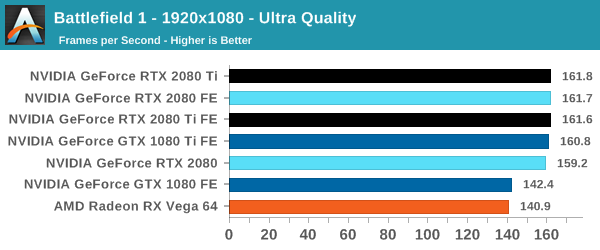 |
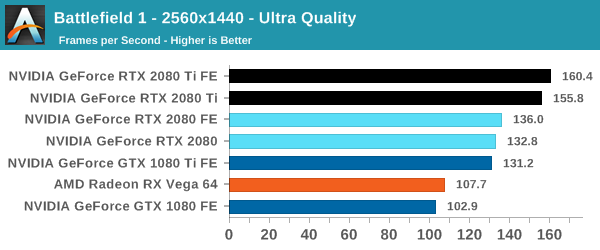 |
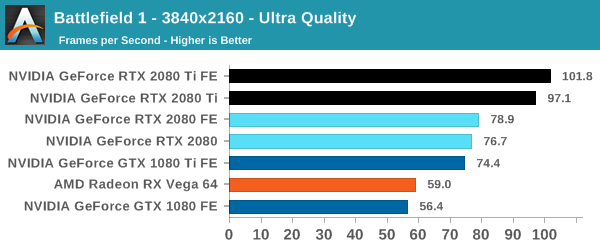 |
| 99th Percentile | 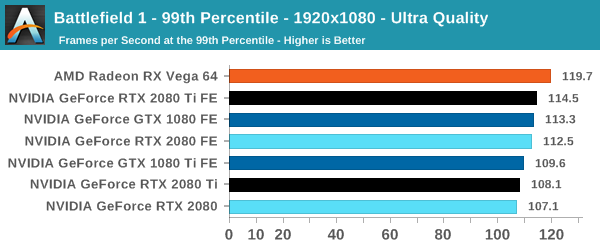 |
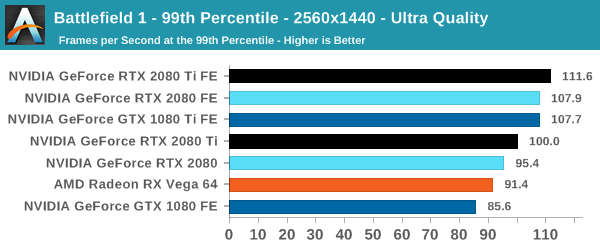 |
 |
At this point, the RTX 2080 Ti is fast enough to touch the CPU bottleneck at 1080p, but it keeps its substantial lead at 4K. Nowadays, Battlefield 1 runs rather well on a gamut of cards and settings, and in optimized high-profile games like these, the 2080 in particular will need to make sure that the veteran 1080 Ti doesn't edge too close. So we see the Founders Edition specs are enough to firmly plant the 2080 Founders Edition faster than the 1080 Ti Founders Edition.
The outlying low 99th percentile reading for the 2080 Ti occurred on repeated testing, and we're looking into it further.












337 Comments
View All Comments
Qasar - Wednesday, September 19, 2018 - link
just checked a local store, the lowest priced 2080 card, a gigabyte rtx 2080 is $1080, and thats canadian dollars... the most expensive RTX card ..EVGA RTX 2080 Ti XC ULTRA GAMING 11GB is $1700 !!!! again that's canadian dollars !! to make things worse.. that's PRE ORDER pricing, and have this disclaimer : Please note that the prices of the GeForce RTX cards are subject to change due to FX rate and the possibility of tariffs. We cannot guarantee preorder prices when the stock arrives - prices will be updated as needed as stock become available.even if i could afford these cards.. i think i would pass.. just WAY to expensive.. id prob grab a 1080 or 1080ti and be done with it... IMO... nvida is being a tad bit greedy just to protect and keep its profit margins.. but, they CAN do this.. cause there is no one else to challenge them...
PopinFRESH007 - Wednesday, September 19, 2018 - link
would you care to share the bill of materials for the tu102 chip? Since you seem to suggest you know the production costs, and therefor know the profit margin which you suggest is a bit greedy.Qasar - Wednesday, September 19, 2018 - link
popin.. all i am trying to say is nvidia doesnt have to charge the prices they are charging.. but they CAN because there is nothing else out there to provide competition...tamalero - Thursday, September 20, 2018 - link
Please again explain how the cost of materials is somehow relevant on the price performance argument for consumers?Chips like R600, Fermi, similars.. were huge.. did it matter? NO, did performance matter? YES.
PopinFRESH007 - Thursday, September 20, 2018 - link
I specifically replied to Qasar's claim "nvida is being a tad bit greedy just to protect and keep its profit margins.. but, they CAN do this" which is baseless unless they have cost information to know what their profit margins are.Nagorak - Thursday, September 20, 2018 - link
Nvidia is a public company. You can look up their profit margin and it is quite high.Qasar - Thursday, September 20, 2018 - link
PopinFRESH * sigh * i guess you will never understand the concept of " no competition, we can charge what ever we want, and people will STILL buy it cause it is the only option if you want the best or fastest " it has NOTHING to do with knowing cost info or what a companies profit margins are... but i guess you will never understand this....just4U - Thursday, September 20, 2018 - link
Ofcourse their being greedy. Since they saw their cards flying off the shelfs at 50% above MSRP earlier this year they know people are willing to pay.. so their pushing the limit. As they normally do.. this isn't new with Nvidia. Not sure why any are defending them.. or getting excessively mad about it. (..shrug)mapesdhs - Wednesday, September 26, 2018 - link
Effectively, gamers are complaining about themselves. Previous cards sold well at higher prices, so NVIDIA thinks it can push up the pricing further, and reduce product resources at the same time even when the cost is higher. If the cards do sell well then gamers only have themselves to blame, in which case nothing will change until *gamers* stop making it fashionable and cool to have the latest and greatest card. Likewise, if AMD does release something competitive, whether via price, performance or both, then gamers need to buy the damn things instead of just exploiting the lowered NVIDIA pricing as a way of getting a cheaper NVIDIA card. There's no point AMD even being in this market if people don't buy their products even when it does make sense to do so.BurntMyBacon - Thursday, September 20, 2018 - link
@PopinFRESH007: "would you care to share the bill of materials for the tu102 chip? Since you seem to suggest you know the production costs, and therefor know the profit margin which you suggest is a bit greedy."You have a valid point. It is hard to establish a profit margin without a bill of materials (among other things). We don't have a bill of materials, but let me establish some knowns so we can better assess.
Typically, most supporting components on a graphics card are pretty similar to previous generation cards. Often times different designs used to do the same function are a cost cutting measure. I'm going to make an assumption that power transistors, capacitors, output connectors, etc. will remain nominally the same cost. So I'll focus on differences. The obvious is the larger GPU. This is not the first chip made on this process (TSMC 12nm) and the process appears to be a half node, so defect rates should be lower and the wafer cost should be similar to TSMC 14nm. On the other hand, the chip is still very large which will likely offset some of that yield gain and reduce the number of chips fabricated per wafer. Pascal was first generation chip produced on a new full node process (TSMC 14nm), but quite a bit smaller, so yields may have been higher and there were more chips fabricated per wafer. Also apparent is the newer GDDR6 memory tech, which will naturally cost more than GDDR5(X) at the moment, but clearly not as much as HBM2. The chips also take more power, so I'd expect a marginal increase for power related circuitry and cooling relative to pascal. I'd expect about the same cost here as for maxwell based chips, given similar power requirements.
From all this, it sounds like graohics cards based on Turing chips will cost more to manufacture than Pascal equivalents. I it is probably not unreasonable to suggest that a TU106 may have a similar cost bill of materials to a GP102 with the note that the cost to produce the GP102 has most certainly dropped since introduction.
I'll leave the debate on how greedy or not this is to others.